 Facebook
Facebook
 X
X
 Instagram
Instagram
 TikTok
TikTok
 Youtube
Youtube
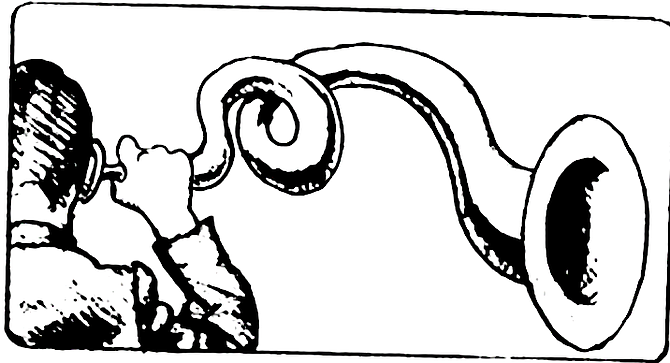

Carlos Bey, Reader contributor
Free Sandwiches
Peanut butter, cheese, or lunch-meat sandwiches given out every day at 3 p.m. at St. Vincent de Paul Thrift Shop, 634 4th, downtown.
Just a Suggestion, You Understand
After returning from Red China in November, Colleen O’Connor said she always believed that “the corporate executives ought to be on the line riveting bolts for a week and they’d improve the working conditions of the workers.”
Cheapest Breakfast
Two eggs, toast, hash brow ns, and coffee for 60 cents at the Sun Cafe on Market Street.

Most Dramatic Political Method
The long lines of Yes-on-14 campaign workers standing on both sides of Ingraham Street, Mission Boulevard, and Pacific Highway waving sombreros and placards at passing cars.
Word of the Year
Casual—originally a substitute for “mellow,” i.e., “The atmosphere was real casual.” Now more commonly “all right,” i.e., “Would it be casual to borrow your bicycle?’
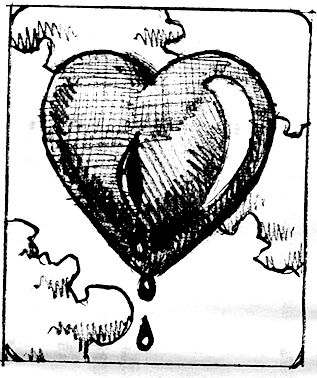
Best Place to Score Dope
Still between the foot of Newport Avenue and the O.B. Pier in Ocean Beach, all the easier if your hair is short and you look like you’re on liberty from boot camp at Naval Training Center.
Most Interesting Acquisition
In 1975 Hugo Mann of West Germany bought controlling stock in FedMart, and the Bank of Tokyo took over Southern California First National Bank. In 1976 Warner Hot Springs. San Diego’s landmark and historical birthplace of the Cuneno Indians, has been sold to a West German corporation, American Ranch Ferien Gmb H & Co. Anlagen K.G., for nearly $10 million.
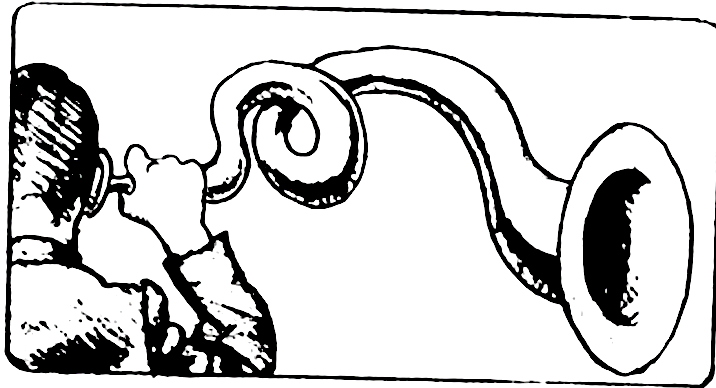
Latest Scam on Lower Broadway
The photo studios near the Tower Theatre where sexist women approach short-haired men and offer them photo blow-ups (pictures of your ship, pictures of liberty in Pago-Pago) for the rest of your life.
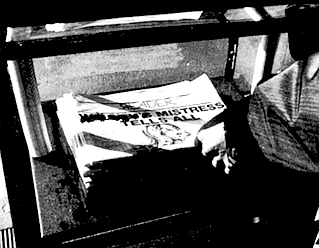
The San Diego Magazine I-Can’t-Get-Enough-of-N'ostalgia Award
Neil Morgan, the Evening Tribune columnist gave his readers yet another account of his migration to California from North Carolina in New West's first issue in April.
Well, It’s All Relative, Isn’t It?
New West, in honoring Helen Copley for her takeover of the Copley Newspapers, cited the fact that she put Neil Morgan, “the paper’s best reporter,’’ on the Union's editorial board.
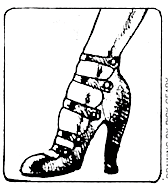
Best Place to Meet a Biker
El Rabo’s in Pacific Beach.
Cheapest Tacos in Town
The Sombrero Taco Shops on g University Avenue and El Cajon Boulevard. 10 for a dollar.
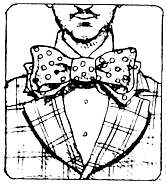
Best Euphemism
Pacific Telephone’s decision to list Hillcrest’s disco club, Dance Your Ass Off (formerly Fat Finger’s, before that Mickey Finn’s), as Dance Your Tail Off.
How To Try At National TV Coverage Without Really Succeeding
After being snubbed by the Ford Re-election Committee, Mayor Wilson finally decided to go to the GOP Convention in Kansas City and in his starring moment when Mike Pettit of NBC was interviewing him on the convention floor, the sound went out.
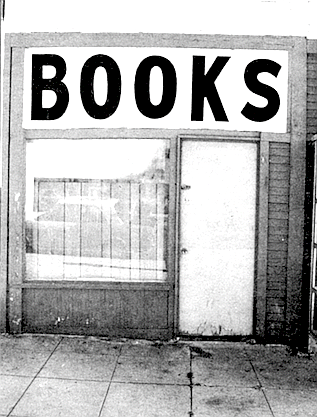
It Was Only Inevitable...
Male nude dancers at the Classic Cat in La Mesa on Wednesday nights.
One Way to Prevent X-Rated Movies
Calvary Chapel bought the North Park Theatre and turned it into a church.
Best Place to Meet a Moonie
Followers of Rev. Sun Moon ply both sides of Broadway and E Street near the Public Library looking for potential converts.
Cheapest Sandwich in Town
Baloney and sauerkraut on hamburger buns for 30 cents at Harry’s Market in Mission Beach.
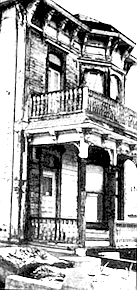
Destroying Downtown in Order to Save It
The new multi-million dollar Federal Building finally opens for business just in time to witness 16 empty floors in the 22-story Central Federal Savings Build and a vacancy rate in the San Diego Federal Savings of 48 perceht.
Worst Place for Thumbing a Ride
Clairemont Mesa Boulevard and 805 North exit.
Most Over-reported Story of 1976
The sailing of the Star of India on July 4.
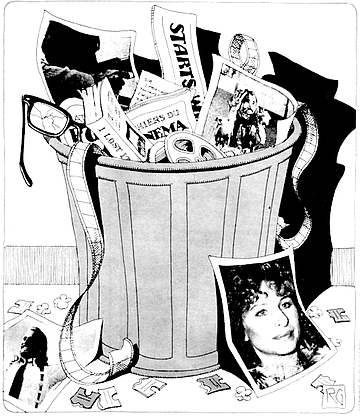
Biggest Understatement of the Year
The Crystal Palace Theatre owners said they were closing down and going to the desert because they needed new material.
C. Arnholt Smith, Where Are You Now?
The San Diego Union ran a series in November mourning the loss of noblesse oblige in the San Diego business community.
Corniest Advertising Approach
I Found It billboards and bumperstickers.
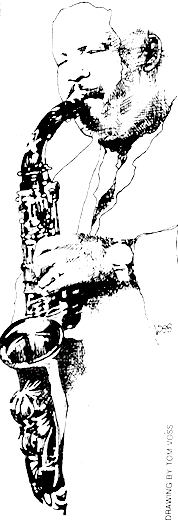
Sourest Advertising Grapes
I Lost It bumperstickers.
Quickest Switch in the West
The removal of the acceptamos pesos mexicanos sign at the Mexican-American Bank.
Most Unbelievable Figure
The report that September’s storm Kathleen showered east San Diego County with 9.86 inches of rain and caused 6-foot waves to wash out a section of Interstate 8
Colleen O’Connor Political Writer

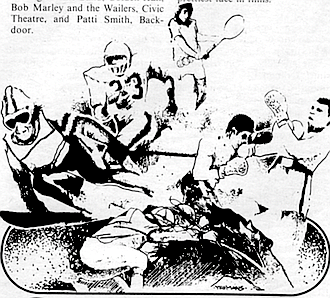
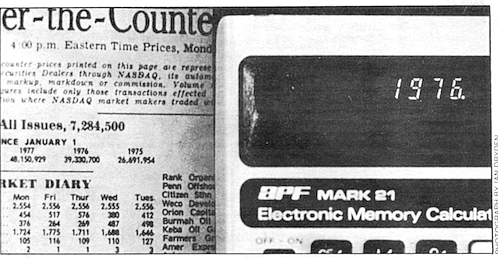
Doug Card, Ocean Beach community worker
Ruth Peyton, Free-lance writer
Jonathan Saville, Reader Theatre Critic
Bill Ritter, Freelance reporter
Mariane Collier, media consultant
John Willkie, free-lance writer
Rochelle Raffee, Something Mad, Fashion Valley
Paul Dimarchi, Lord Rebel Men's Store, Fashion Valley
Fred Moramarco, director, School of Literature San Diego State
The Madrid Codices of Leonardo DaVinci. The six sumptuous volumes of this set published by McGraw Hill cost $1,250 and come in a plexiglass case. Last Christmas (1975) the publisher offered them at $750. This is not inflation, they tell us, but investment. For the commoners, there’s a volume called The Unknown Leonardo from the same publisher for a mere $34.95. I’d like to have read the former so that when I spied the latter on somebody’s glass and chrome coffee table I could say. “Nice book, but have you read The Madrid Codices?"
To Jerusalem and Back by Saul Bellow. This is also a very good book for the art of upmanship. Since Bellow won the Nobel Prize, everybody’s read Humboldt's Gift (especially since it’s out now in paper), but having read his newest would allow me to say things like, “He’s a fine novelist, but I think non-fiction is his real metier. Have you read his travel book about Jerusalem?”
Terra Nostra by Carlos Fuentes. This is a novel I really wish I’d read and may yet read if I can get over the phobia I have about dense and portentous novels over 750 pages that I caught from trying to read Gravity’s Rainbow by Thomas Pynchon and JR by William Gaddis. Both those are also books I wish I’d read—that is, finished.
The Hite Report. A Nationwide Study of Female Sexuality by Shere Hite. I wish I’d read this because tbc subject sounds interesting.
Lying, Despair, Jealousy, Envy. Sex, Suicide, Drugs and the Good Life by Leslie Farbcr. Don’t you wish you'd read a book with this’ title?
The Canfield Decision by Spiro T. Agnew. Reading this would spoil the fun of reading Nixon’s memoirs next year. Besides, the author’s true literary forte is alliterative invective (remember “nattering nabobs of negativism”?) and not the novel.
Born Again by Charles Colson. This is described by the New York Times as an “Evangelical autobiography by the former White House hatchet man.” Enough reason to be glad not to have read it.
Blind Ambition by John Dean. I’ll have to admit to some ambivalence on this one. Finally I skipped it because I couldn’t stand the idea of paying royalties to John Dean.
A New Age Now Begins (2 volumes) by Page Smith. Billed as a “People’s history of the American Revolution,” this turns out to be (everywhere I opened it) a chronicle of generals and battles. I tried to do my Bicentennial duty, but couldn’t make it.
Why Not the Best? by Jimmy Carter. This is only one of the many Presidential campaign books that I'm glad I didn’t read.
Harry Belten and the Mendelssohn Violin Concerto by Barry Targan. This collection of short stories won the University of Iowa Prize for Short Fiction in 1975 but not many people seem to have noticed it. Targan is a marvelous new writer and deserves a lot more readers than he has.
The View from Highway 1, Essays on Television by Michael Arlen. Actually I read these all in The New Yorker, but now they’ve been collected in book form. If there is anyone who write about television more lucidly and intelligently than Michael Arlen, please let me know.
The Time of Illusion by Jonathan Schell. If you simply must read a Watergate book, this is the one. Schell contrasts what was going on day by day in the Nixon Administration with what was being reported in the press. A revelatory book.
Women of the Shadows by Ann Cornelisen. Cornelison writes with great sensitivity about the peasant women of Southern Italy. A unique and deeply moving book.
Self Portrait in a Convex Mirror by John Ashberry. Ashberry’s latest book of poems won the National Book Award, the Pulitzer Prize, and the New York Book Critics Award for Poetry last year. It’s now available in paper from Penguin. Run out and get a copy if you haven’t read it yet.
Body, Mind, Behavior by Maggie Scarf. I'm glad I finally found someone who can write about developments in the Social and Behavioral Sciences with clarity and wit and without jargon. No easy task.
Talking at the Boundaries by David Antin. A San Diego poet invents a new verse form, which he calls the "talk poem.” The book recreates a lively sense of Antin’s traveling around America delivering his performances at various universities. galleries, etc. It's a very innovative bit of work.
Passages. Predictable Crises of Adult Life by Gail Sheehy. I put this here very reluctantly because it’s a very interesting book. I'm sorry I read it, though, because I hate to think that life is so damned predictable. Who wants to know that their own personal traumas and crises are common? Passages records the death throes of Western Individualism.
Travesties by John Hawkes. It’s always difficult to watch one of your favorite writers slide into self-parody and downhill. I'm sorry I read this because I liked The Lime Twig and The Blood Oranges so much that I wish they were the last Hawkes novels I read.
Slapstick by Kurt Vonnegut Jr. Vonnegut has become a master of the sort of novel you can read in its entirety at one standing, in a bookstore. This one is a classic of the genre. As a matter of fact, that’s how I read it. Hi Ho.
Bruce Kamerling, president, Save Our Heritage Organization
SOHO Condemns
SOHO Applauds
SOHO also notes with pleasure the good things being done in outlying communities such as the restoration of the McKinney house (1908) by the La Mesa Historical Society, and the restoration of the Granger Music Hall( 1896-98) by the South Bay Historical Society.
Duncan Shepherd, Reader film critic
Ken Kramer, Kramer’s Folk, KPBS-FM
The voice on the telephone is softspoken and the words carefully measured. “I'm a local musician,” he says, “and I was wondering how somebody gets on your program?” “Well,” comes the reply, “sounds good. Where can I hear you perform? Are you working in town?” “Actually,” the caller says, “I was hoping that somebody might be listening and want to hire me.”
W.B. Reid, a young and immensely talented blues guitarist and folk singer, drops by with his skilled performing partner Jay Waelder. Together they've developed a tight act. Of the local grassroots country-folk and string band groups Bruce and Jay as The Fly By Nyte Review are the hottest. They talk of having opened the Don McLean concert a few weeks back, and of working briefly at Mountain Mama's. They've done a wedding. They’re booked into Orango’s in a couple of months. Meanwhile, they play for quarters in the park. They, too, are out of steady work.
Kenny Hall, probably the finest mandolin picker west of the Mississippi River, plays a two-week engagement at a hamburger and beer bar in Hillcrest.
Martin Henry, a superb country music performer, plays a weekend at a local music store. He takes home a fistful of small bills and change that might cover the cost of his gasoline.
Lani Kurnik admits that she’s looking for something better than the YMCA hoots. And Lani, you deserve better. But San Diego's restaurants and clubs will continue to reflect the public “Captain and Tenille” preference for reverberated pop-vocal with leisure suit electric piano back-up. And though we folk fans may continue to grouse about local talent being unappreciated and underpaid. I’m often given to wonder how much we have done to advance the cause.
As an example, there are few who would dispute the caliber of talent appearing at the San Diego Folk Festival. That one gathering of musicians creates tremendous good feeling in the folk community for the music that is performed and exchanged there. But there is apparently much bitterness among the San Diego artists who may receive limited pay, or be asked to appear in concerts and workshops for nothing.
A good night may find Orango’s restaurant seating 25 people for a show. The Folk Arts concerts drew perhaps a dozen. Another example of the lukewarm regard that the local folk establishment has for San Diego performers? Perhaps that. But also it illustrates the fact that San Diego's “folk scene” lacks any sense of promotion. In contrast, a second example is provided by San Diego folk singers Walt Richards and Howard Caine. Walt has been among folk musicians in San Diego for years; his skills as a folk performer are unquestioned. Howard is a famed actor and able folksinger and he will be happy to tell you. The two were booked into Orango's for one weekend last year. They made the personal effort to enthusiastically spread the word that those concerts would be special events. Capacity crowds attended both performances. They may not have been so significant musically, but they were a demonstration that San Diego will turn out and appreciate a professional presentation by artists who believe in themselves. That Walt Richards-Howard Caine program will remain an important event not so much for w hat happened on the stage as for the message that emerged from its success. We can be proud of boosting the folk music of our local artists, or San Diego can settle for being a silent flag-stop for performers from Seattle, San Francisco and Los Angeles.
Lou Curtiss, Folk Arts Rare Records
Any year-end review must start with the San Diego State University Folk Festival. Now in its 11th year, it sets the tone for much of what happens in our area. At the festival (coming up April 19-24) it’s possible to hear such imports as Louisiana Cajun music, Mississippi Delta blues, Cape Breton Island fiddling, and the men and women who made classic recordings in the 20s and 30s. This yearly influx of various styles continues to have a profound impact on local performers, and has been the inspiration for such gatherings as the Balboa Park Banjo and Fiddle Contests, the New England-style country dances at United Commercial Travellers Hall, and the folk concerts at Orango's restaurant. The festival and its spinoffs provide San Diego with the opportunity to hear old time music on a fairly regular basis, but there arc needs as yet unfulfilled.
First, we need a good coffee house run by people who know something about old time music and will hire local musicians. The Orango’s concerts have been a stop-gap measure, but can't continue alone. For a town that once had 15 or 20 places for local musicians to play and didn't cater to a cocktail bar crowd, it sure would be nice to have just one place today.
Secondly, we could use more varied radio programming. There was a time when local stations provided listeners with a decent cross section of tastes, but now there seems to be a mad rush to converge on an A Flat monotone. It sells, and it’s sad. One notable exception is KPBS FM (89.5) at San Diego State which programs a wide variety of old time music including the Folk Festival USA series. Ken Kramer’s nightly folk show, the Steve I.aVere blues show, and starting in March, Ken Swerilas and I will be doing an old time country music show. The only other station helping matters is KSON with Wayne Rice and his bluegrass show on Sundays.
Finally, I must complain about you, the San Diegans who don't attend concerts, or go to meetings, or write letters to radio stations making your feelings known. Please remember, the folk scene here is w hat you make it. Have an old timey year.
Franklin Pierce, musician
Jonathan Saville, Reader music critic
Steve Esmedina, Reader contributor
Best albums
Creative Orchestra Music, Anthony Braxton; The People’s Republic, The Revolutionary Ensemble; Red Card. Streetwalkers; Coincide, Dewey Redman; Another Green World. Eno; Closeness, Charlie Haden; Some People Can Do What They Like, Robert Palmer; For Players Only, Jazz Composers Orchestra; A Sight on the Town, Rod Stewart; The Wild Tchoupitoulas.
Special Awards
Alan Pesin, Reader sports writer
Boxing—In Yankee Stadium, on a chill September '76 evening, defending heavyweight champion Muhammad Ali was thoroughly pummeled by the game's number one contender. Ken Norton. Despite the obvious, both judges and the referee awarded the unanimous decision to the champ Ali. Evidence to the contrary notwithstanding, all protests proved futile. Norton returned to Hollywood to continue his movie career, newly martyred. More upset was O.J. Simpson, who still hopes someday to become the face in films.
Football—After years of constant bickering and dickering, San Diego Charger Coy Bacon was finally traded to a contending team, the Cincinnati Bengals. Week after week Bacon led the Bengals to victory. On nationally televised games he excelled. His Sunday afternoon fumble-recovery-long run-lateral touchdown and Monday night sacks of James Harris were replayed again and again. Then with Bacon's most cherished ambition, the playoffs, just one win away, the Bengals were blown out by Oakland. After the game, a dejected Bacon announced his retirement. The Steelers clinched the playoff berth the following Saturday. On Sunday the down-in-the-mouth. Bacon-less Bengals played at Shea Stadium against the Jets and Joe Namath’s swan song at quarterback. The Bengals. fifteen point favorites at the beginning of the week, were only favored by eleven points at game time. But Cincinnati desecrated the Jets 42-3. On Grandstand. Bacon was the featured performer, smothering Namath again and again. Somebody had forgotten that Bacon's second most cherished ambition was making the All-Pro team just one more time. More upset was Guy Dennis who. having forgot, bet S20 on the Jets.
Horse Racing—The Kentucky Derby found Foolish Pleasure’s brother-in-law. Honest Pleasure, favored over a weak field which included Puerto Rican-owned Bold Foiltes. who had lost two sprint races at Santa Anita to a non-stakes winning colt. Sure Fire. Over one million dollars was wagered on Honest Pleasure at Churchill Downs racetrack, another million at the future books in Nevada and Mexico, and a few million more w ith illegal bookies around the country. Bold Forbes won wire-lo-wire. Most upset was President Ford, who bided his time, then announced his intention to make Puerto Rico the 51st state, thereby subjecting Puerto Ricans to the federal income tax for the first time.
Skiing—Vladimir “Spider” Sabich. who received press credentials for the 1976 Winter Olympics through the good offices of a powerful friend at the Games, was unsuccessful in his attempt to gain photo credentials for his girlfriend Claudine Longet, w ho was forced to watch the action on a fuzzy television set. Most upset was (w'ho else?) Claudine Longet, who bided her time, then asked Spider to teach her how to fire a gun at point-blank range.
Tennis- Because of a bad back and sprained ankle. Jimmy Connors’ mother announced that Jimmy would have to pass up playing for the United States in the Davis Cup regionals in order to play for $160,000 in the Caesar's Palace WCT Challenge Cup. After whipping through his three opponents (despite a bad limp and a hunched posture). Connors, his girlfriend, and his mother retired to the penthouse suite of San Diego’s luxurious Westgate Plaza Hotel for a short recuperation period. Most upset was C. Arnholt Smith, who broke into hives when he saw a long-hair without a lie sta)ing in his monument to good banking practices.
Michele Dennis, financial analyst
The Roller Coaster Award
To Rohr Industries, which had its shareholders scared to death throughout the year with gigantic losses and skirmishes with banks— but then turned to doubling the price of the stock in December.
The Unhappy Shareholders' Award
To FedMart Corporation management whose tact in handling founder and ousted chairman Sol Price and sympathetic shareholders was tantamount to Sherman marching through Georgia. And just about as expensive, once court costs are figured.
The Lifesaving Award
To Bob Dicker, president of Walker Scott, whose resuscitation of the department store chain just may mean survival for one of San Diego’s traditions.
The Hide-and-Go-Seek Award
A tie, to both Cubic Corporation and lvac Corporation, two local companies that decided in 1976 to hold their annual meetings in New York.
Master Stroke in Investments
To George Soares, former chief executive of Campbell Industries, who acquired 2.700 shares of the company’s stock in October, only to see Campbell voluntarily halt trading in November. Soares was fired in December.
Top Investment of the Year
The Mexican peso, for those who sold short. Unfortunately, though, most San Diego investors went long.
Corporate Planning Award
To Sea World, which did nothing to prevent an MCA Corporation takeover when the Los Angeles-based company bought eight percent of Sea World stock in August. No wonder the company expressed surprise when MCA made an unfriendly bid for the company in November. (There is a happy ending, however, for Harcourt-Brace-Jovanovich made a larger bid of $50 million and peacefully acquired Sea World.)
The Gourmet Award
To the hardworking environmentalists, who are doing their best to make tuna the rare delicacy that salmon is.
Interest in the Community Award
To San Diego Trust and Savings Bank, which declined to shell out $1,000 for a membership in the Economic Research Development Corporation, a group which works to bring new industry to San Diego.
Sale of the Year
To Calbiochem. which sold its Triazure drug in 1975 and not only avoided bankruptcy by doing so but also regained fiscal health. In August of 1976, the drug was pulled off the market by the Food & Drug Administration, at relatively little cost to Biochem.
Prodigal Son Award
To Imperial Savings and Loan, which after years of changing locations for its top executives, finally brought them back here.
Nearsighted Loan Policies
To Home Federal Savings and Loan, which has had to extricate itself this year on loans made in years past to the like of Royal Inns of America, Saratoga Development and Le Baron Hotels—all in bankruptcy.
Eleanor Widmer, Reader food critic
Since we tend to be a nation that breeds and discards fashions in a hurry, the types of restaurants that proliferate in any given year reflect the general concern with novelty, rather than quality.
To begin with the most obvious trend, 1976 saw the multiplication in more than necessary numbers of the soup kitchen. When the first local soup kitchen appeared on the scene at the end of 1975 (The Hungry Years, Clairemont Mesa Boulevard), it seemed a welcome addition to our dining concept. Now. there are so many soup and salad bars that they are barely worth noting, the latter-day versions of cafeterias. While they each advertise a "home-made product” (often the bread), the soups are usually commercially canned, with a few fresh vegetables added to preserve the myth of “home-made.”
Of the soup kitchens. The Gazebo has the least appetizing of soups and salads. and its atmosphere, unlike the slick Soup Exchange and Village Kettle, both in I.a Jolla, does reflect the urgent grubbiness of the 30s. Frankly, these soup kitchens are not the bargains they are alleged to be. In theory, each is an "all you can eat” place. In fact, you can't eat much of the soups or the salads because they don't stimulate the taste buds. Unless, like Beowulf, you can gulp things piecemeal, the soup kitchen doesn’t prove too satisfactory for dinner, though it may have some virtues as a cafeteria for lunch. The “all you can eat” gimmick proves to be just that. It's conceivably better to have one excellent cup of soup than the possibility of 4 or 5 mediocre to bad ones. Most soup kitchens that I visit are jammed, which can be attributed less to the quality of the food than the desire for propinquity, the same phenomenon of mass participation in crowded beaches on Sunday.
At the other end of the spectrum, disappointment came from the so-called posh restaurants, dinners of over $10 per person. Of these, Mon Ami in Solana Beach offered much clashing of knives and the wheeling of carts, but the courses are too many without any of them being first-rate or outstanding.
When I visited France, I was often amazed at the ceremony of carving, only to find one slice of meat on my plate, along with a heavy portion of gristle. At Mon Ami. the slicing of a pear for dessert is an exhibition not to be missed, but gazing upon the thin soggy slice of pear and the soft cherries that I would reject at any supermarket, I marveled at the gap between the concept and the realization. The idea of a prix fixe dinner ($12.95) with soup, pate, sausage, salad, seafood, meat, dessert, seemed fine. But nothing quite works at Mon Ami.
La Maison ties Pescadeux in Ocean Beach and Casino Valadier in Pacilic Beach arc also uneven in their dishes, although the patio at the Casino Valadier and the atmosphere within are charming. Both of these are costly beyond what they produce.
A pleasant surprise in the $10 and up dinner proved Trelowarth's in La Jolla. The physical setting is unpromising but the international cuisine offers a chance for adventure.
What has added most to creating a more cosmopolitan atmosphere in San Diego is the rise of the ethnic restaurant. In former times, ethnic in San Diego meant Mexican. At present we have a spate of Lebanese, Korean, Greek, even Portuguese. Of the Lebanese, the Haiji Baba on Garnet Avenue offers the most for your money. Ahn's, on Engineer Avenue, is the most Americanized of the Korean (not too much garlic or peppers) and Seoul House, on Adams Avenue, is closer to authentic Korean cooking without overbearing seasoning.
I’m sorry about the demise of the Greek restaurant, the Acropolis Express, which the owners, with rancor, attributed to my negative review. Two weeks before the place closed. I did return, and the owner, without knowing who I was, castigated "that awful review woman.” It's not my intention to close down small businesses, but even with the new cook at the Acropolis Express and the improvement in the moussaka, the place had an air of demoralization: the dishes were too cold and brought at the wrong time. The owner implored my party, including myself, to sign a petition against "this terrible person.” Yet the function of the reviewer is to assess and a evaluate. Inevitably, this creates pain.
John Canady, the reviewer of the New York Times, reported that he frequently received calls of desperation from small restaurants that were failing. But when he sometimes acceded to the pleas he knew almost immediately why the place was doomed to fail: insufficient performance in a competitive world.
It would give me pleasure to praise, rather than detract, from the worth of restaurants. Yet this is an imperfect world and with it must be included far from perfect restaurants. Most of the new seafood restaurants, including Jacob Taylor's in Solana Beach, are exploitative in price. The two Basque restaurants. The Halcyon and the Villa Basque duplicate each other's menus. Chu Dynasty in Coronado offers fine Mandarin food, as does the vegetarian restaurant, the Prophet. But I can't praise many of the other vegetarian places because vegetarian doesn't necessarily equal good.
What’s left? Always the hope that 1977 will produce the restaurant with excellent food and service at the modest total price of $6. I can dream, can’t I?



Carlos Bey, Reader contributor
Free Sandwiches
Peanut butter, cheese, or lunch-meat sandwiches given out every day at 3 p.m. at St. Vincent de Paul Thrift Shop, 634 4th, downtown.
Just a Suggestion, You Understand
After returning from Red China in November, Colleen O’Connor said she always believed that “the corporate executives ought to be on the line riveting bolts for a week and they’d improve the working conditions of the workers.”
Cheapest Breakfast
Two eggs, toast, hash brow ns, and coffee for 60 cents at the Sun Cafe on Market Street.

Most Dramatic Political Method
The long lines of Yes-on-14 campaign workers standing on both sides of Ingraham Street, Mission Boulevard, and Pacific Highway waving sombreros and placards at passing cars.
Word of the Year
Casual—originally a substitute for “mellow,” i.e., “The atmosphere was real casual.” Now more commonly “all right,” i.e., “Would it be casual to borrow your bicycle?’

Best Place to Score Dope
Still between the foot of Newport Avenue and the O.B. Pier in Ocean Beach, all the easier if your hair is short and you look like you’re on liberty from boot camp at Naval Training Center.
Most Interesting Acquisition
In 1975 Hugo Mann of West Germany bought controlling stock in FedMart, and the Bank of Tokyo took over Southern California First National Bank. In 1976 Warner Hot Springs. San Diego’s landmark and historical birthplace of the Cuneno Indians, has been sold to a West German corporation, American Ranch Ferien Gmb H & Co. Anlagen K.G., for nearly $10 million.

Latest Scam on Lower Broadway
The photo studios near the Tower Theatre where sexist women approach short-haired men and offer them photo blow-ups (pictures of your ship, pictures of liberty in Pago-Pago) for the rest of your life.

The San Diego Magazine I-Can’t-Get-Enough-of-N'ostalgia Award
Neil Morgan, the Evening Tribune columnist gave his readers yet another account of his migration to California from North Carolina in New West's first issue in April.
Well, It’s All Relative, Isn’t It?
New West, in honoring Helen Copley for her takeover of the Copley Newspapers, cited the fact that she put Neil Morgan, “the paper’s best reporter,’’ on the Union's editorial board.

Best Place to Meet a Biker
El Rabo’s in Pacific Beach.
Cheapest Tacos in Town
The Sombrero Taco Shops on g University Avenue and El Cajon Boulevard. 10 for a dollar.

Best Euphemism
Pacific Telephone’s decision to list Hillcrest’s disco club, Dance Your Ass Off (formerly Fat Finger’s, before that Mickey Finn’s), as Dance Your Tail Off.
How To Try At National TV Coverage Without Really Succeeding
After being snubbed by the Ford Re-election Committee, Mayor Wilson finally decided to go to the GOP Convention in Kansas City and in his starring moment when Mike Pettit of NBC was interviewing him on the convention floor, the sound went out.

It Was Only Inevitable...
Male nude dancers at the Classic Cat in La Mesa on Wednesday nights.
One Way to Prevent X-Rated Movies
Calvary Chapel bought the North Park Theatre and turned it into a church.
Best Place to Meet a Moonie
Followers of Rev. Sun Moon ply both sides of Broadway and E Street near the Public Library looking for potential converts.
Cheapest Sandwich in Town
Baloney and sauerkraut on hamburger buns for 30 cents at Harry’s Market in Mission Beach.

Destroying Downtown in Order to Save It
The new multi-million dollar Federal Building finally opens for business just in time to witness 16 empty floors in the 22-story Central Federal Savings Build and a vacancy rate in the San Diego Federal Savings of 48 perceht.
Worst Place for Thumbing a Ride
Clairemont Mesa Boulevard and 805 North exit.
Most Over-reported Story of 1976
The sailing of the Star of India on July 4.

Biggest Understatement of the Year
The Crystal Palace Theatre owners said they were closing down and going to the desert because they needed new material.
C. Arnholt Smith, Where Are You Now?
The San Diego Union ran a series in November mourning the loss of noblesse oblige in the San Diego business community.
Corniest Advertising Approach
I Found It billboards and bumperstickers.

Sourest Advertising Grapes
I Lost It bumperstickers.
Quickest Switch in the West
The removal of the acceptamos pesos mexicanos sign at the Mexican-American Bank.
Most Unbelievable Figure
The report that September’s storm Kathleen showered east San Diego County with 9.86 inches of rain and caused 6-foot waves to wash out a section of Interstate 8
Colleen O’Connor Political Writer



Doug Card, Ocean Beach community worker
Ruth Peyton, Free-lance writer
Jonathan Saville, Reader Theatre Critic
Bill Ritter, Freelance reporter
Mariane Collier, media consultant
John Willkie, free-lance writer
Rochelle Raffee, Something Mad, Fashion Valley
Paul Dimarchi, Lord Rebel Men's Store, Fashion Valley
Fred Moramarco, director, School of Literature San Diego State
The Madrid Codices of Leonardo DaVinci. The six sumptuous volumes of this set published by McGraw Hill cost $1,250 and come in a plexiglass case. Last Christmas (1975) the publisher offered them at $750. This is not inflation, they tell us, but investment. For the commoners, there’s a volume called The Unknown Leonardo from the same publisher for a mere $34.95. I’d like to have read the former so that when I spied the latter on somebody’s glass and chrome coffee table I could say. “Nice book, but have you read The Madrid Codices?"
To Jerusalem and Back by Saul Bellow. This is also a very good book for the art of upmanship. Since Bellow won the Nobel Prize, everybody’s read Humboldt's Gift (especially since it’s out now in paper), but having read his newest would allow me to say things like, “He’s a fine novelist, but I think non-fiction is his real metier. Have you read his travel book about Jerusalem?”
Terra Nostra by Carlos Fuentes. This is a novel I really wish I’d read and may yet read if I can get over the phobia I have about dense and portentous novels over 750 pages that I caught from trying to read Gravity’s Rainbow by Thomas Pynchon and JR by William Gaddis. Both those are also books I wish I’d read—that is, finished.
The Hite Report. A Nationwide Study of Female Sexuality by Shere Hite. I wish I’d read this because tbc subject sounds interesting.
Lying, Despair, Jealousy, Envy. Sex, Suicide, Drugs and the Good Life by Leslie Farbcr. Don’t you wish you'd read a book with this’ title?
The Canfield Decision by Spiro T. Agnew. Reading this would spoil the fun of reading Nixon’s memoirs next year. Besides, the author’s true literary forte is alliterative invective (remember “nattering nabobs of negativism”?) and not the novel.
Born Again by Charles Colson. This is described by the New York Times as an “Evangelical autobiography by the former White House hatchet man.” Enough reason to be glad not to have read it.
Blind Ambition by John Dean. I’ll have to admit to some ambivalence on this one. Finally I skipped it because I couldn’t stand the idea of paying royalties to John Dean.
A New Age Now Begins (2 volumes) by Page Smith. Billed as a “People’s history of the American Revolution,” this turns out to be (everywhere I opened it) a chronicle of generals and battles. I tried to do my Bicentennial duty, but couldn’t make it.
Why Not the Best? by Jimmy Carter. This is only one of the many Presidential campaign books that I'm glad I didn’t read.
Harry Belten and the Mendelssohn Violin Concerto by Barry Targan. This collection of short stories won the University of Iowa Prize for Short Fiction in 1975 but not many people seem to have noticed it. Targan is a marvelous new writer and deserves a lot more readers than he has.
The View from Highway 1, Essays on Television by Michael Arlen. Actually I read these all in The New Yorker, but now they’ve been collected in book form. If there is anyone who write about television more lucidly and intelligently than Michael Arlen, please let me know.
The Time of Illusion by Jonathan Schell. If you simply must read a Watergate book, this is the one. Schell contrasts what was going on day by day in the Nixon Administration with what was being reported in the press. A revelatory book.
Women of the Shadows by Ann Cornelisen. Cornelison writes with great sensitivity about the peasant women of Southern Italy. A unique and deeply moving book.
Self Portrait in a Convex Mirror by John Ashberry. Ashberry’s latest book of poems won the National Book Award, the Pulitzer Prize, and the New York Book Critics Award for Poetry last year. It’s now available in paper from Penguin. Run out and get a copy if you haven’t read it yet.
Body, Mind, Behavior by Maggie Scarf. I'm glad I finally found someone who can write about developments in the Social and Behavioral Sciences with clarity and wit and without jargon. No easy task.
Talking at the Boundaries by David Antin. A San Diego poet invents a new verse form, which he calls the "talk poem.” The book recreates a lively sense of Antin’s traveling around America delivering his performances at various universities. galleries, etc. It's a very innovative bit of work.
Passages. Predictable Crises of Adult Life by Gail Sheehy. I put this here very reluctantly because it’s a very interesting book. I'm sorry I read it, though, because I hate to think that life is so damned predictable. Who wants to know that their own personal traumas and crises are common? Passages records the death throes of Western Individualism.
Travesties by John Hawkes. It’s always difficult to watch one of your favorite writers slide into self-parody and downhill. I'm sorry I read this because I liked The Lime Twig and The Blood Oranges so much that I wish they were the last Hawkes novels I read.
Slapstick by Kurt Vonnegut Jr. Vonnegut has become a master of the sort of novel you can read in its entirety at one standing, in a bookstore. This one is a classic of the genre. As a matter of fact, that’s how I read it. Hi Ho.
Bruce Kamerling, president, Save Our Heritage Organization
SOHO Condemns
SOHO Applauds
SOHO also notes with pleasure the good things being done in outlying communities such as the restoration of the McKinney house (1908) by the La Mesa Historical Society, and the restoration of the Granger Music Hall( 1896-98) by the South Bay Historical Society.
Duncan Shepherd, Reader film critic
Ken Kramer, Kramer’s Folk, KPBS-FM
The voice on the telephone is softspoken and the words carefully measured. “I'm a local musician,” he says, “and I was wondering how somebody gets on your program?” “Well,” comes the reply, “sounds good. Where can I hear you perform? Are you working in town?” “Actually,” the caller says, “I was hoping that somebody might be listening and want to hire me.”
W.B. Reid, a young and immensely talented blues guitarist and folk singer, drops by with his skilled performing partner Jay Waelder. Together they've developed a tight act. Of the local grassroots country-folk and string band groups Bruce and Jay as The Fly By Nyte Review are the hottest. They talk of having opened the Don McLean concert a few weeks back, and of working briefly at Mountain Mama's. They've done a wedding. They’re booked into Orango’s in a couple of months. Meanwhile, they play for quarters in the park. They, too, are out of steady work.
Kenny Hall, probably the finest mandolin picker west of the Mississippi River, plays a two-week engagement at a hamburger and beer bar in Hillcrest.
Martin Henry, a superb country music performer, plays a weekend at a local music store. He takes home a fistful of small bills and change that might cover the cost of his gasoline.
Lani Kurnik admits that she’s looking for something better than the YMCA hoots. And Lani, you deserve better. But San Diego's restaurants and clubs will continue to reflect the public “Captain and Tenille” preference for reverberated pop-vocal with leisure suit electric piano back-up. And though we folk fans may continue to grouse about local talent being unappreciated and underpaid. I’m often given to wonder how much we have done to advance the cause.
As an example, there are few who would dispute the caliber of talent appearing at the San Diego Folk Festival. That one gathering of musicians creates tremendous good feeling in the folk community for the music that is performed and exchanged there. But there is apparently much bitterness among the San Diego artists who may receive limited pay, or be asked to appear in concerts and workshops for nothing.
A good night may find Orango’s restaurant seating 25 people for a show. The Folk Arts concerts drew perhaps a dozen. Another example of the lukewarm regard that the local folk establishment has for San Diego performers? Perhaps that. But also it illustrates the fact that San Diego's “folk scene” lacks any sense of promotion. In contrast, a second example is provided by San Diego folk singers Walt Richards and Howard Caine. Walt has been among folk musicians in San Diego for years; his skills as a folk performer are unquestioned. Howard is a famed actor and able folksinger and he will be happy to tell you. The two were booked into Orango's for one weekend last year. They made the personal effort to enthusiastically spread the word that those concerts would be special events. Capacity crowds attended both performances. They may not have been so significant musically, but they were a demonstration that San Diego will turn out and appreciate a professional presentation by artists who believe in themselves. That Walt Richards-Howard Caine program will remain an important event not so much for w hat happened on the stage as for the message that emerged from its success. We can be proud of boosting the folk music of our local artists, or San Diego can settle for being a silent flag-stop for performers from Seattle, San Francisco and Los Angeles.
Lou Curtiss, Folk Arts Rare Records
Any year-end review must start with the San Diego State University Folk Festival. Now in its 11th year, it sets the tone for much of what happens in our area. At the festival (coming up April 19-24) it’s possible to hear such imports as Louisiana Cajun music, Mississippi Delta blues, Cape Breton Island fiddling, and the men and women who made classic recordings in the 20s and 30s. This yearly influx of various styles continues to have a profound impact on local performers, and has been the inspiration for such gatherings as the Balboa Park Banjo and Fiddle Contests, the New England-style country dances at United Commercial Travellers Hall, and the folk concerts at Orango's restaurant. The festival and its spinoffs provide San Diego with the opportunity to hear old time music on a fairly regular basis, but there arc needs as yet unfulfilled.
First, we need a good coffee house run by people who know something about old time music and will hire local musicians. The Orango’s concerts have been a stop-gap measure, but can't continue alone. For a town that once had 15 or 20 places for local musicians to play and didn't cater to a cocktail bar crowd, it sure would be nice to have just one place today.
Secondly, we could use more varied radio programming. There was a time when local stations provided listeners with a decent cross section of tastes, but now there seems to be a mad rush to converge on an A Flat monotone. It sells, and it’s sad. One notable exception is KPBS FM (89.5) at San Diego State which programs a wide variety of old time music including the Folk Festival USA series. Ken Kramer’s nightly folk show, the Steve I.aVere blues show, and starting in March, Ken Swerilas and I will be doing an old time country music show. The only other station helping matters is KSON with Wayne Rice and his bluegrass show on Sundays.
Finally, I must complain about you, the San Diegans who don't attend concerts, or go to meetings, or write letters to radio stations making your feelings known. Please remember, the folk scene here is w hat you make it. Have an old timey year.
Franklin Pierce, musician
Jonathan Saville, Reader music critic
Steve Esmedina, Reader contributor
Best albums
Creative Orchestra Music, Anthony Braxton; The People’s Republic, The Revolutionary Ensemble; Red Card. Streetwalkers; Coincide, Dewey Redman; Another Green World. Eno; Closeness, Charlie Haden; Some People Can Do What They Like, Robert Palmer; For Players Only, Jazz Composers Orchestra; A Sight on the Town, Rod Stewart; The Wild Tchoupitoulas.
Special Awards
Alan Pesin, Reader sports writer
Boxing—In Yankee Stadium, on a chill September '76 evening, defending heavyweight champion Muhammad Ali was thoroughly pummeled by the game's number one contender. Ken Norton. Despite the obvious, both judges and the referee awarded the unanimous decision to the champ Ali. Evidence to the contrary notwithstanding, all protests proved futile. Norton returned to Hollywood to continue his movie career, newly martyred. More upset was O.J. Simpson, who still hopes someday to become the face in films.
Football—After years of constant bickering and dickering, San Diego Charger Coy Bacon was finally traded to a contending team, the Cincinnati Bengals. Week after week Bacon led the Bengals to victory. On nationally televised games he excelled. His Sunday afternoon fumble-recovery-long run-lateral touchdown and Monday night sacks of James Harris were replayed again and again. Then with Bacon's most cherished ambition, the playoffs, just one win away, the Bengals were blown out by Oakland. After the game, a dejected Bacon announced his retirement. The Steelers clinched the playoff berth the following Saturday. On Sunday the down-in-the-mouth. Bacon-less Bengals played at Shea Stadium against the Jets and Joe Namath’s swan song at quarterback. The Bengals. fifteen point favorites at the beginning of the week, were only favored by eleven points at game time. But Cincinnati desecrated the Jets 42-3. On Grandstand. Bacon was the featured performer, smothering Namath again and again. Somebody had forgotten that Bacon's second most cherished ambition was making the All-Pro team just one more time. More upset was Guy Dennis who. having forgot, bet S20 on the Jets.
Horse Racing—The Kentucky Derby found Foolish Pleasure’s brother-in-law. Honest Pleasure, favored over a weak field which included Puerto Rican-owned Bold Foiltes. who had lost two sprint races at Santa Anita to a non-stakes winning colt. Sure Fire. Over one million dollars was wagered on Honest Pleasure at Churchill Downs racetrack, another million at the future books in Nevada and Mexico, and a few million more w ith illegal bookies around the country. Bold Forbes won wire-lo-wire. Most upset was President Ford, who bided his time, then announced his intention to make Puerto Rico the 51st state, thereby subjecting Puerto Ricans to the federal income tax for the first time.
Skiing—Vladimir “Spider” Sabich. who received press credentials for the 1976 Winter Olympics through the good offices of a powerful friend at the Games, was unsuccessful in his attempt to gain photo credentials for his girlfriend Claudine Longet, w ho was forced to watch the action on a fuzzy television set. Most upset was (w'ho else?) Claudine Longet, who bided her time, then asked Spider to teach her how to fire a gun at point-blank range.
Tennis- Because of a bad back and sprained ankle. Jimmy Connors’ mother announced that Jimmy would have to pass up playing for the United States in the Davis Cup regionals in order to play for $160,000 in the Caesar's Palace WCT Challenge Cup. After whipping through his three opponents (despite a bad limp and a hunched posture). Connors, his girlfriend, and his mother retired to the penthouse suite of San Diego’s luxurious Westgate Plaza Hotel for a short recuperation period. Most upset was C. Arnholt Smith, who broke into hives when he saw a long-hair without a lie sta)ing in his monument to good banking practices.
Michele Dennis, financial analyst
The Roller Coaster Award
To Rohr Industries, which had its shareholders scared to death throughout the year with gigantic losses and skirmishes with banks— but then turned to doubling the price of the stock in December.
The Unhappy Shareholders' Award
To FedMart Corporation management whose tact in handling founder and ousted chairman Sol Price and sympathetic shareholders was tantamount to Sherman marching through Georgia. And just about as expensive, once court costs are figured.
The Lifesaving Award
To Bob Dicker, president of Walker Scott, whose resuscitation of the department store chain just may mean survival for one of San Diego’s traditions.
The Hide-and-Go-Seek Award
A tie, to both Cubic Corporation and lvac Corporation, two local companies that decided in 1976 to hold their annual meetings in New York.
Master Stroke in Investments
To George Soares, former chief executive of Campbell Industries, who acquired 2.700 shares of the company’s stock in October, only to see Campbell voluntarily halt trading in November. Soares was fired in December.
Top Investment of the Year
The Mexican peso, for those who sold short. Unfortunately, though, most San Diego investors went long.
Corporate Planning Award
To Sea World, which did nothing to prevent an MCA Corporation takeover when the Los Angeles-based company bought eight percent of Sea World stock in August. No wonder the company expressed surprise when MCA made an unfriendly bid for the company in November. (There is a happy ending, however, for Harcourt-Brace-Jovanovich made a larger bid of $50 million and peacefully acquired Sea World.)
The Gourmet Award
To the hardworking environmentalists, who are doing their best to make tuna the rare delicacy that salmon is.
Interest in the Community Award
To San Diego Trust and Savings Bank, which declined to shell out $1,000 for a membership in the Economic Research Development Corporation, a group which works to bring new industry to San Diego.
Sale of the Year
To Calbiochem. which sold its Triazure drug in 1975 and not only avoided bankruptcy by doing so but also regained fiscal health. In August of 1976, the drug was pulled off the market by the Food & Drug Administration, at relatively little cost to Biochem.
Prodigal Son Award
To Imperial Savings and Loan, which after years of changing locations for its top executives, finally brought them back here.
Nearsighted Loan Policies
To Home Federal Savings and Loan, which has had to extricate itself this year on loans made in years past to the like of Royal Inns of America, Saratoga Development and Le Baron Hotels—all in bankruptcy.
Eleanor Widmer, Reader food critic
Since we tend to be a nation that breeds and discards fashions in a hurry, the types of restaurants that proliferate in any given year reflect the general concern with novelty, rather than quality.
To begin with the most obvious trend, 1976 saw the multiplication in more than necessary numbers of the soup kitchen. When the first local soup kitchen appeared on the scene at the end of 1975 (The Hungry Years, Clairemont Mesa Boulevard), it seemed a welcome addition to our dining concept. Now. there are so many soup and salad bars that they are barely worth noting, the latter-day versions of cafeterias. While they each advertise a "home-made product” (often the bread), the soups are usually commercially canned, with a few fresh vegetables added to preserve the myth of “home-made.”
Of the soup kitchens. The Gazebo has the least appetizing of soups and salads. and its atmosphere, unlike the slick Soup Exchange and Village Kettle, both in I.a Jolla, does reflect the urgent grubbiness of the 30s. Frankly, these soup kitchens are not the bargains they are alleged to be. In theory, each is an "all you can eat” place. In fact, you can't eat much of the soups or the salads because they don't stimulate the taste buds. Unless, like Beowulf, you can gulp things piecemeal, the soup kitchen doesn’t prove too satisfactory for dinner, though it may have some virtues as a cafeteria for lunch. The “all you can eat” gimmick proves to be just that. It's conceivably better to have one excellent cup of soup than the possibility of 4 or 5 mediocre to bad ones. Most soup kitchens that I visit are jammed, which can be attributed less to the quality of the food than the desire for propinquity, the same phenomenon of mass participation in crowded beaches on Sunday.
At the other end of the spectrum, disappointment came from the so-called posh restaurants, dinners of over $10 per person. Of these, Mon Ami in Solana Beach offered much clashing of knives and the wheeling of carts, but the courses are too many without any of them being first-rate or outstanding.
When I visited France, I was often amazed at the ceremony of carving, only to find one slice of meat on my plate, along with a heavy portion of gristle. At Mon Ami. the slicing of a pear for dessert is an exhibition not to be missed, but gazing upon the thin soggy slice of pear and the soft cherries that I would reject at any supermarket, I marveled at the gap between the concept and the realization. The idea of a prix fixe dinner ($12.95) with soup, pate, sausage, salad, seafood, meat, dessert, seemed fine. But nothing quite works at Mon Ami.
La Maison ties Pescadeux in Ocean Beach and Casino Valadier in Pacilic Beach arc also uneven in their dishes, although the patio at the Casino Valadier and the atmosphere within are charming. Both of these are costly beyond what they produce.
A pleasant surprise in the $10 and up dinner proved Trelowarth's in La Jolla. The physical setting is unpromising but the international cuisine offers a chance for adventure.
What has added most to creating a more cosmopolitan atmosphere in San Diego is the rise of the ethnic restaurant. In former times, ethnic in San Diego meant Mexican. At present we have a spate of Lebanese, Korean, Greek, even Portuguese. Of the Lebanese, the Haiji Baba on Garnet Avenue offers the most for your money. Ahn's, on Engineer Avenue, is the most Americanized of the Korean (not too much garlic or peppers) and Seoul House, on Adams Avenue, is closer to authentic Korean cooking without overbearing seasoning.
I’m sorry about the demise of the Greek restaurant, the Acropolis Express, which the owners, with rancor, attributed to my negative review. Two weeks before the place closed. I did return, and the owner, without knowing who I was, castigated "that awful review woman.” It's not my intention to close down small businesses, but even with the new cook at the Acropolis Express and the improvement in the moussaka, the place had an air of demoralization: the dishes were too cold and brought at the wrong time. The owner implored my party, including myself, to sign a petition against "this terrible person.” Yet the function of the reviewer is to assess and a evaluate. Inevitably, this creates pain.
John Canady, the reviewer of the New York Times, reported that he frequently received calls of desperation from small restaurants that were failing. But when he sometimes acceded to the pleas he knew almost immediately why the place was doomed to fail: insufficient performance in a competitive world.
It would give me pleasure to praise, rather than detract, from the worth of restaurants. Yet this is an imperfect world and with it must be included far from perfect restaurants. Most of the new seafood restaurants, including Jacob Taylor's in Solana Beach, are exploitative in price. The two Basque restaurants. The Halcyon and the Villa Basque duplicate each other's menus. Chu Dynasty in Coronado offers fine Mandarin food, as does the vegetarian restaurant, the Prophet. But I can't praise many of the other vegetarian places because vegetarian doesn't necessarily equal good.
What’s left? Always the hope that 1977 will produce the restaurant with excellent food and service at the modest total price of $6. I can dream, can’t I?
Comments